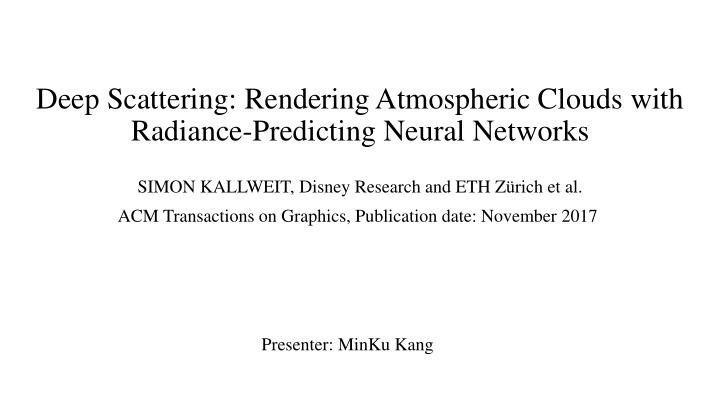



Deep Scattering: Rendering Atmospheric Clouds with Radiance-Predicting Neural Networks SIMON KALLWEIT, Disney Research and ETH Zürich et al. ACM Transactions on Graphics, Publication date: November 2017 Presenter: MinKu Kang
In Previous Talk from Dennis Ambient sound propagation
Cloud Rendering edge-darkening effects silverlining https://www.youtube.com/watch?v=0MJl9IF_3fI
Scattering of Light Light scattering in microscale , not just in macro scale http://ww2010.atmos.uiuc.edu/(Gh)/guides/mtr/opt/mch/sct.rxml
Problem Configuration & Notation 𝜕: 𝑒𝑗𝑠𝑓𝑑𝑢𝑗𝑝𝑜 𝑦: 𝑚𝑝𝑑𝑏𝑢𝑗𝑝𝑜 We want to know (compute) the radiance at ( 𝑦 , 𝜕 ) To render a whole cloud image, We need to know the radiance at all (visible) positions and directions Problem : How to efficiently compute the radiance at a specific position and a direction ?
Problem Configuration & Notation 𝜕: 𝑒𝑗𝑠𝑓𝑑𝑢𝑗𝑝𝑜 𝑦: 𝑚𝑝𝑑𝑏𝑢𝑗𝑝𝑜 We want to know (compute) the radiance at ( 𝑦 , 𝜕 ) To render a whole cloud image, We need to know the radiance at all (visible) positions and directions But , there are too many discrete particles to consider Problem : How to efficiently compute the (they are not even polygons!). Is this possible to use rendering equation we have radiance at a specific position and a direction ? learned ?
Radiative Transfer The radiative transfer equation Integrating both sides of the differential RTE along ω : extinction coefficient
Radiative Transfer Boundary 𝑑𝑝𝑜𝑢𝑠𝑗𝑐𝑣𝑢𝑗𝑝𝑜 𝑔𝑏𝑑𝑢𝑝𝑠: 𝜕 ∙ ෝ 𝜕 𝜕 ෝ Neighborhood 𝜕 surface 𝑇 2 𝑦
RADIANCE-PREDICTING NEURAL NETWORKS The in-scattered radiance Rule out uncollided radiance (directly from the sun) This is what the NN predicts (estimate)
A combination of Monte Carlo integration and neural networks Monte-Carlo Integration The in-scattered radiance This is what the NN predicts (estimate)
RADIANCE-PREDICTING NEURAL NETWORKS Want to find (learn) a function Such that, given S : shading configuration around 𝑦, 𝜕 it predicts
RADIANCE-PREDICTING NEURAL NETWORKS Want to find (learn) a function via using
The Descriptor at a specific configuration ( 𝑦, 𝜕 ) Each descriptor consists of 5 × 5 × 9 stencils • • The stencil is oriented towards the light source The stencil at level k is scaled by 2 𝑙−1 • • Two levels of the hierarchy are shown here • They use K=10 levels (10 stenciles) • Each stencil is formed by 225 points
The Descriptor at a specific configuration ( 𝑦, 𝜕 ) 𝑦: 𝑚𝑝𝑑𝑏𝑢𝑗𝑝𝑜 𝜕: 𝑒𝑗𝑠𝑓𝑑𝑢𝑗𝑝𝑜 𝜕 𝑚 : 𝑒𝑗𝑠𝑓𝑑𝑢𝑗𝑝𝑜 𝑢𝑝𝑥𝑏𝑠𝑒𝑡 𝑢ℎ𝑓 𝑚𝑗ℎ𝑢 𝑡𝑝𝑣𝑠𝑑𝑓 The Descriptor:
Neural Network Architecture (progressive feeding) The most finest scale stencil The most coarse scale Outout (L)
Training Configuration Ground Truth data from Path Tracing N = ~15 million samples Adam update rule using the default learning rate The minibatches of size |B| = 1000 It requires ∼ 12 h of training on a single GPU
Result (Test Time) Path Tracing Radiance-Predicting Neural Networks (RPNN)
Result (Test Time) They argued that RPNN (seconds to minutes.) converges 24 times faster than PT
Experiment - Neural Network Architecture Validation error Progressive feeding The entire stencil hierarchy is input to the first layer This highlights the benefit of the progressive feeding that provides means to better adapt to signals at different frequency scales.
Experiment – Stencil Size Validation error A good balance between accuracy and the cost of querying the density values and number of trainable parameters in the network
Summary Radiative Transfer Equation (RTE) Progressive Feeding Neural Network Hierarchical Stencil Descriptor
Recommend
More recommend